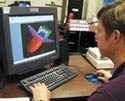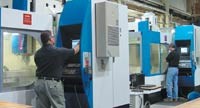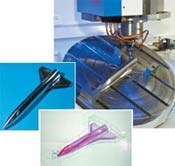Modeling The Future
During an era of reduced budgets, NASA launches a metalworking capability for the 21st century.
On July 20, 1969, Neil Armstrong became the first human to set foot on the moon when America’s space program reached the lofty goal established by President Kennedy in his memorable address to Congress in May 1961. The first lunar expedition also represented the zenith of public support for the efforts of the National Aeronautics and Space Administration (NASA). But even as the Apollo 11 astronauts made their fiery return to a triumphant celebration, NASA’s budget appropriations were already in the midst of a precipitous decline.
From a 1964 high-water mark, when NASA funding represented approximately 3.8 percent of the entire federal budget, the agency’s share of the federal pie had dwindled to less than 1 percent by 1974. During the past 25 years, NASA’s average annual budget share has remained below 1 percent. At NASA’s Langley Research Center (Hampton, Virginia), this cost-cutting severely limited machine tool procurement for more than 2 decades.
Established in 1917, Langley was the nation’s first civilian aeronautical research facility. Langley’s early visitors included the Wright brothers and Amelia Earhart. During World War II, studies of pilotless aircraft at Langley led to the advent of research for the space program. Langley engineers supervised the initial Mercury space program, as well as the subsequent Gemini and Apollo programs. Many of the early astronaut training programs were also conducted at Langley. Perhaps the most important contribution to the space program, however, was Langley’s development of the lunar-orbit rendezvous (LOR) concept that utilized three spacecraft modules. This research formed the basis of NASA’s Apollo moon missions.
Because of scarce resources since those heady times, however, Langley’s Metals Applications Technology Branch found itself trapped in a technological time warp. While the capabilities of its machine tools remained static, the complexity of aerospace models demanded by Langley’s internal and external customers increased year by year. Demonstrating remarkable skill and ingenuity, Langley’s machine shop team continued to produce prototypes of the latest aerospace designs using many of the same machine tools that were in operation when Alan Shepard made his historic 1961 flight aboard Freedom 7.
A New Direction
In 1998, NASA formed a team of research scientists, engineers and manufacturing technicians to investigate how new technology might dramatically reduce the delivery time for its wind tunnel models. “The Langley Research Center Wind Tunnel Enterprise (WTE) was charged with streamlining and modernizing the complete research cycle for model programs from conception to data delivery,” says Michael Tall, supervisor of the facility’s Numerical Control Section. “The manufacturing competency goal for fiscal year 2003 is to reduce our metallic model hardware delivery by one order of magnitude.”
To pursue this goal, Langley enlisted the assistance of Professor Sanjay Sarma from the Massachusetts Institute of Technology’s (MIT) Department of Mechanical Engineering. “Professor Sarma toured our facility as a manufacturing consultant, critically examining our work requirements, machine tools and manufacturing processes for areas of improvement,” says Mr. Tall.
Although Professor Sarma was extremely impressed by the high level of performance attained at Langley with its existing equipment, his report concluded that any further reductions in machining cycle time could only be realized with the aid of new technology. Despite the previous absence of funding for new machine tools, the Langley staff had stayed abreast of technological developments in the metalworking industry.
“We had seen lots of mold applications for high speed machining, but we were skeptical about whether this technology could substantially improve an operation like ours that specializes in producing a solid wind tunnel model,” says Mr. Tall. “We needed a technology that addressed our goals of improving metal-removal rates and substantially reducing machining time.”
NASA’s initial interest in high speed machining derived from some inescapable facts of life that govern its operations. First, because Langley is a research facility, timely reporting of test results depends on a predictable process that also affords some flexibility. Second, manufacturing and design development are concurrent processes at Langley. For this reason, the scope and requirements of a particular job can change frequently in midstream.
Before they attended a 1999 trade show, however, Mr. Tall and his colleague, Bruce McLemore, weren’t convinced that they could benefit from high speed machining. “We learned about IMTA (Rockford, Illinois) at the show in Rosemont, Illinois,” says Mr. McLemore. “We called them and asked whether they were familiar with wind tunnel models and machining with 15-5 stainless steel.”
When the NASA team visited his office, CEO Tino Oldani exhibited a section of a wind tunnel model that conformed to their requirements. “We asked if they could machine one of our parts using material that we supplied,” says Mr. McLemore. “One week later, the part was completed with the required surface finish, and the total machining time was well within our time reduction goal.”
Based on this demonstration, as well as IMTA’s capability to provide complete training and support during its transition to a new process, NASA decided to purchase two Huron (Illkirch, France) high speed machining centers. IMTA also provided the NASA team with 12 weeks of hands-on training, ranging from basic principles of high speed machining to continuous five-axis machining.
In addition, IMTA is providing ongoing technical support via its ImtaSmart database portal system. The PC-based system allows the NASA team to access information that ranges from basic programming skills for high speed machining to the specifics of cutting parameters and tool inventory management. The video conference module enables real-time reviews of application issues, including technical support and remote diagnostics/troubleshooting. “We believe that high speed machining is not so much about a specific machine, a specific spindle or cutter,” says Mr. Oldani. “Primarily, it involves a new mentality in manufacturing.”
The machinery that NASA has chosen for pursuing this strategy includes a five-axis Huron KX15 machine and a three-axis KX30. The five-axis machine incorporates a table with continuous, 360-degree C-axis rotation and +20 to –100 degree A-axis tilting range. Connected via Ethernet to the ImtaSmart system, both machines are linked with IMTA and Huron’s technical support. This connection permits real-time diagnosis of machining problems and allows remote operation of the machines for testing purposes.
Great Expectations
Although the Langley machine shop has only a few months’ experience with the new machines, NASA is quite pleased with the preliminary results. During its initial training process, NASA machined some generic “bathtub” models composed of the 15-5 PH stainless steel that is used to produce many of Langley’s wind tunnel models. Using the high speed equipment, total machining time for these trial parts was seven times faster than the time required when using Langley’s existing process.
In a second training test, total cycle time to machine a stainless steel wingtip spar component for a wind tunnel model was reduced to less than half of its previous level. In this test, actual machining time was reduced to less than 25 percent of its previous duration.
Although the primary manufacturing goal of NASA’s WTE was to reduce machining cycle time, Mr. Tall says, “The spinoffs from this new technology have been considerable.” Perhaps the most important of these collateral benefits has been a drastic reduction in hand-finishing operations as the result of the excellent surface smoothness achieved with high speed finish milling. “This will enable us to move our models directly from manufacturing to testing,” says Mr. Tall.
Using the new equipment, the NASA team has already achieved surface quality of 16-20 rms. At this level of smoothness, only buffing operations are necessary to improve final surface quality to the specifications required for some of Langley’s models.
One important effect related to the substantial reduction in hand-finishing is greater aerodynamic symmetry of the models. When an aerospace design is tested in a wind tunnel, even the most subtle variations between opposing sides or wings can adversely affect the prototype’s performance. While it’s quite difficult for humans to maintain strict uniformity from side to side when hand-finishing these models, high speed CNC machinery consistently produces accurate symmetrical forms. Mr. Tall anticipates that this will translate to substantially less tweaking of models because of variations identified in testing.
Another factor of key importance is the effect of inherent mechanical stress released from metals or redistributed during the machining process. Maintaining flatness and straightness of finished parts is always a challenge for machine shops, but this is particularly true with regard to the flight-critical features of Langley’s wind tunnel models. Because high speed machining exerts less cutting force and generates less heat than conventional machining, finished parts are straighter and more accurate.
“Although we continue to stress-relieve metal before or during machining, we are seeing less cutter-induced stresses,” says Mr. Tall. “This reduces or eliminates the time to re-flatten the hardware for final finishing.” In addition, Langley’s new process eliminates or drastically simplifies final fitting operations for part assemblies.
Handling “fatal events” is a critical factor for Langley, as well as for any machine shop that produces prototypes or singular finished parts. The time necessary to recover from an accident or error that ruins a prototype part can represent a major hitch in the R&D cycle. A key advantage of NASA’s new equipment, therefore, is its capability to dramatically shorten this recovery time.
In the past, a damaged wind tunnel model represented the loss of a huge amount of time. Today, however, the Langley team looks forward to substantial reductions in recovery time that will allow NASA to avoid undue delays in its research process. Even when no errors are made, however, in-process design changes that are facts of life at NASA can also disrupt the manufacturing-to-testing process. In this vein, the greater speed and flexibility of Langley’s new machinery represents a key benefit.
Balance And Harmony
Optimizing tool paths to find “sweet spots” for various speeds and feedrates is another crucial consideration for Langley’s machine shop. To this end, NASA is currently participating in a project financed by a co-funded National Science Foundation grant to MIT and supervised by Professor Sarma. This study, titled “Generating Machine-Optimal NC Code (CNC toolpath optimization for high speed machining),” represents a departure from current CAM systems that generate tool paths strictly on the basis of a part’s geometry.
Because CAM programs generate the same tool paths regardless of a particular machine’s dynamic characteristics, these parameters cannot truly be optimized. MIT has developed a method to incorporate the machine tool’s specific kinematics and dynamics into the generation of NC tool paths. MIT and Unigraphics Solutions (Waltham, Massachusetts) are currently discussing licensing opportunities for this system.
In practice, a user of this system selects the specific machine tool type from a menu of icons. When tool paths are generated, they are automatically shaped to conform to the operational characteristics of the particular machine tool. This technology is particularly applicable for generating five-axis tool paths. Although harmonization of tool paths may also be accomplished by external means, incorporating this function into the initial path-generation process is a more practical strategy. “Langley’s two new high speed machines will be the test-bed for codes and algorithms developed by this initiative,” says Mr. Tall.
Once toolpaths have been optimized, tool balancing is also critical for accuracy and proper surface finish in high speed machining. Langley typically machines wind tunnel models at speeds of 600-700 sfm with spindle speeds of 6,000-15,000 rpm. Cutting tools are balanced each time they are changed, and Langley’s balancing machine, manufactured by CEMB (Mandello del Lario, Italy) is accurate to within 0.1 gram per meter.
Mission Possible
Streamlining production operations is just as important for NASA’s Langley machining facility as it is for any privately owned machine shop. But while a more efficient process represents the key to competitiveness and profitability in a private machine shop, the NASA team views its new technology as a means for extending Langley’s charter as the nation’s foremost center for aeronautical research.
NASA’s investment in the high speed machining centers reflects the same commitment to excellence that enabled men to walk on the moon, and that today allows unmanned spacecraft to investigate the far reaches of the cosmos. Having already realized some profound benefits from its new machining process, the Langley team now perceives its ultimate goal of lights-out machining on the horizon. Intrigued by Langley’s early success with high speed machining, NASA’s other research facilities have been following these developments closely.
Examining the complex and futuristic aerospace designs currently being developed at Langley, it’s impossible not to appreciate the stratospheric level of teamwork and commitment that makes these ventures possible. Mike Tall describes the exhilaration he felt when witnessing a space shuttle launch at Kennedy Space Center—knowing the crucial role that Langley’s designs have played in the space program’s success. Likewise, metalworking professionals can take considerable pride in the fact that their experience, hard work and creativity continue to play a leading role in America’s technological triumphs.
Read Next
The Cut Scene: The Finer Details of Large-Format Machining
Small details and features can have an outsized impact on large parts, such as Barbco’s collapsible utility drill head.
Read More3 Mistakes That Cause CNC Programs to Fail
Despite enhancements to manufacturing technology, there are still issues today that can cause programs to fail. These failures can cause lost time, scrapped parts, damaged machines and even injured operators.
Read More








.jpg;width=860)









.png;maxWidth=300;quality=90)





.png;maxWidth=300;quality=90)



